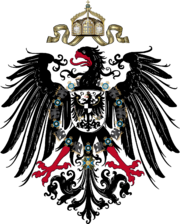Qingdao
| Qingdao | |||
| — Sub-provincial city — | |||
| Chinese transcription(s) | |||
| - Simplified | 青岛 | ||
|---|---|---|---|
| - Traditional | 青島 | ||
| - Pinyin | Qīngdǎo | ||
 |
|||
|
|||
| Nickname(s): Qindao | |||
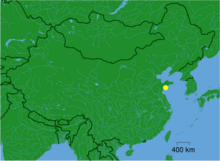 |
|||
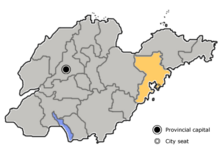 |
|||
| Coordinates: | |||
| Country | China | ||
| Province | Shandong | ||
| City seat | Shinan District | ||
| Government | |||
| - CPC Secretary | Yan Qijun (阎启俊) | ||
| - Mayor | Xia Geng (夏耕) | ||
| Area | |||
| - Sub-provincial city | 10,654.1 km² (4,113.6 sq mi) | ||
| - Urban | 1,102 km² (425.5 sq mi) | ||
| Population (2007) | |||
| - Sub-provincial city | 7,579,900 | ||
| - Density | 711.5/km² (1,842.7/sq mi) | ||
| - Urban | 2,755,500 | ||
| - Urban Density | 2,500.5/km² (6,476.1/sq mi) | ||
| Time zone | China Standard (UTC+8) | ||
| Postal code | 266000 | ||
| Area code(s) | 532 | ||
| GDP | RMB¥ 378.65 billion (2007) | ||
| GDP per capita | RMB¥ 50,616 (2007) | ||
| License Plate Prefix | 鲁B & 鲁U | ||
| Coastline | 862.64 km (inclusive of offshore islands) 730.64 km (exclusive of islands) |
||
| Major Nationalities | Han - 99.86% | ||
| County-level divisions | 12 | ||
| Website: http://www.qingdao.gov.cn/ | |||
Qingdao (simplified Chinese: 青岛; traditional Chinese: 青島; pinyin: Qīngdǎo; Wade-Giles: Ch'ing-tao), best known in the West by its Postal map spelling Tsingtao, is a sub-provincial city in eastern Shandong province, People's Republic of China. It borders Yantai to the northeast, Weifang to the west and Rizhao to the southwest. Lying across the Shandong Peninsula while looking out to the Yellow Sea, Qingdao today is a major seaport, naval base, and industrial center. It is also the site of the Tsingtao Brewery. The character 青 (qīng) in Chinese means "green" or "lush," while the character 岛 (dǎo) means "island." It was recently named China's 9th-most livable city by China Daily.[1]
Contents |
Additional names
- Jiāo'ào (胶澳): former name during Qing Dynasty.
- Qindao (琴岛, lit. "Stringed Instrument Isle"): additional modern name for the area, refers according to locals to the shape of the coastline.
- Tsingtau: German name during concession period and in German language literature.
- Tsingtao: western postal name.
Administrative divisions

Early times
| Urban Areas | Chinese (Simplified / Traditional) | Pinyin |
|---|---|---|
| Shinan | 市南 / 市南 | Shìnán |
| Shibei | 市北 / 市北 | Shìběi |
| Taixi | 台西 / 台西 | Táixī |
| Taidong | 台东 / 台東 | Táidōng |
| Sifang | 四方 / 四方 | Sìfāng |
| Cangkou | 沧口 / 滄口 | Cāngkǒu |
| Haixi | 海西 / 海西 | Hǎixī |
| Suburbs | ||
| Licun | 李村 / 李村 | Lǐcūn |
| Laoshan | 崂山 / 嶗山 | Láoshān |
| Jimo | 即墨 / 即墨 | Jímò |
| Jiaozhou | 胶州 / 膠州 | Jiāozhōu |
Present time
The sub-provincial city of Qingdao administers 12 county-level divisions, including 7 districts and 5 county-level cities.

| English Name | Chinese Name (Simplified / Traditional) | Pin yin | Area (km²) | Population | Post Code | ID Cards* |
|---|---|---|---|---|---|---|
| Shinan District | 市南区 / 市南區 | Shìnán Qū | 30 | 430,000 | 266000 | 370202 |
| Shibei District | 市北区 / 市北區 | Shìběi Qū | 29 | 470,000 | 266000 | 370203 |
| Sifang District | 四方区 / 四方區 | Sìfāng Qū | 35 | 360,000 | 266000 | 370205 |
| Licang District | 李沧区 / 李滄區 | Lǐcāng Qū | 98 | 280,000 | 266000 | 370213 |
| Laoshan District | 崂山区 / 嶗山區 | Láoshān Qū | 389 | 190,000 | 266100 | 370212 |
| Huangdao District | 黄岛区 / 黃島區 | Huángdǎo Qū | 277 | 260,000 | 266000 | 370211 |
| Chengyang District | 城阳区 / 城陽區 | Chéngyáng Qū | 553 | 430,000 | 266000 | 370214 |
| Jiaozhou City | 胶州市 / 膠州市 | Jiāozhōu Qū | 1210 | 750,000 | 266300 | 370281 |
| Jiaonan City | 胶南市 / 膠南市 | Jiāonán Qū | 1927 | 840,000 | 266400 | 370284 |
| Jimo City | 即墨市 / 即墨市 | Jímò Qū | 1727 | 1070,000 | 266200 | 370282 |
| Pingdu City | 平度市 / 平度市 | Píngdù Shì | 3166 | 1330,000 | 266700 | 370283 |
| Laixi City | 莱西市 / 萊西市 | Láixī Shì | 1522 | 720,000 | 266600 | 370285 |
*These codes are being used by ID cards.
Geography and climate
Qingdao is located on the south facing coast of the Shandong Peninsula. It borders three prefecture-level cities, namely Yantai to the northeast, Weifang to the west, and Rizhao to the southwest. The city's total jurisdiction area occupies 10,654km². The populated sections of the city are relatively flat while mountains spur up within city limits and nearby. The highest elevation in the city is 1133 m above sea level. 15.5% of the total area is highland, while the foothill, plain and lowland areas constitute 25.1%, 37.8% and 21.7%. The city has a 730.64-kilometre coastline. Five significant rivers that flow for more than 50km can be found in the region.
Qingdao has a warm temperate zone monsoon climate, with the characteristics of a marine climate, such as moist air, abundant rainfall, and four distinct seasons. Winter is cold, snowy, and windy, with temperatures hovering around freezing. Summer is warm to hot, but very hot days are rare. Due to its proximity to the coast and being on a peninsula, it experiences a one-month delayed spring compared to most of central China. Conversely, autumn is much milder than inland areas. The water temperature peaks at about 25C (77F) in late August, with swimming possible two months on either side.
| Month | Jan | Feb | Mar | Apr | May | Jun | Jul | Aug | Sep | Oct | Nov | Dec | |
|---|---|---|---|---|---|---|---|---|---|---|---|---|---|
| Average high °C (°F) | 3 (37) |
5 (41) |
9 (49) |
15 (59) |
21 (69) |
24 (75) |
27 (81) |
28 (83) |
26 (78) |
20 (68) |
12 (54) |
6 (42) |
|
| Average low °C (°F) | -3 (27) |
-1 (30) |
3 (37) |
8 (47) |
13 (56) |
18 (65) |
22 (72) |
23 (74) |
19 (67) |
13 (56) |
7 (44) |
0 (32) |
|
| Precipitation mm (inches) | 9.9 (0.39) |
11.9 (0.47) |
15.5 (0.61) |
23.9 (0.94) |
44.7 (1.76) |
58.7 (2.31) |
100.1 (3.94) |
105.9 (4.17) |
45.7 (1.80) |
23.1 (0.91) |
23.4 (0.92) |
8.1 (0.32) |
|
| Source: {{{source}}} {{{accessdate}}} | |||||||||||||
History

Ancient times
Human settlement in the area dates back 6,000 years. The Dongyi nationality, one of the important origins of the Chinese nation, lived here and created the Dawenkou, Longshan and Dongyeshi cultures. In the Eastern Zhou Dynasty (770BC~256BC), the town of Jimo was established, which was then the second largest one in the Shandong region. By the end of the Qing Dynasty, Qingdao had grown into a prosperous town. The area in which Qingdao is located today was named Jiao'ao (胶澳) when it was administered by the Qing Dynasty on 14 June, 1891.
German colonial period and Japanese occupation

In 1891, the Qing Government decided to make the area a primary defence base against naval attacks, and planned the construction of a city. Little was done, however, until 1897 when the city was ceded to Germany. The Germans soon turned Tsingtao into a strategically important port administered by the Imperial Department of the Navy (Reichsmarineamt) rather than the Imperial Colonial Office (Reichskolonialamt). The navy based their Far East Squadron here, allowing them to conduct operations throughout the Pacific. From 1898 the marines of III. Seebatallion were based at Tsingtao. The German imperial government planned and built the first streets and institutions of the city we see today, as well as a sewer system and a safe drinking water supply; commercial interests established the world-famous Tsingtao Brewery. German influence extended to other areas of Shandong Province, including the establishment of diverse commercial enterprises.
At the outbreak of World War I the German naval forces under Admiral Graf von Spee left Tsingtao for the central and eastern Pacific in an effort to reach Germany rather than being trapped in the harbour by Allied fleets.[2][3]
After a minor British naval attack on the German colony in 1914, Japan occupied the city and the surrounding province during the Siege of Tsingtao after Japan's declaration of war on Germany in accordance with the Anglo-Japanese Alliance. The failure of the Allied powers to restore Chinese rule to Shandong after the war triggered the May Fourth Movement. For details on the colonial period, see Jiaozhou Bay

The city reverted to Chinese rule in December, 1922, under control of the Republic of China. The city became a direct-controlled municipality of the ROC Government in 1929. Japan re-occupied Qingdao in 1938 with its plans of territorial expansion onto China's coast.
Post-World War II
After World War II the KMT allowed Qingdao to serve as the headquarters of the Western Pacific Fleet of the US Navy in 1945. On 2 June, 1949 the CCP-led Red Army entered Qingdao and the city and province have been under PRC control since that time.
Since the 1984 inauguration of China's open-door policy to foreign trade and investment, Qingdao has developed quickly as a modern port city. It is now the headquarters of the Chinese navy's northern fleet. An early example of the open-door policy occurred on November 5 1984, when three United States Naval vessels visited Qingdao. This was the first US port call in more than 37 years to China. USS Rentz (FFG-46), USS Reeves (DLG-24) and USS Oldendorf (DD-972) and their crews were officially hosted by the Chinese People's Liberation Army Navy (PLAN).
Qingdao is now a manufacturing centre. The city has recently experienced a strong growth period, with a new central business district created to the east of the older business district. Outside of the center of the city there is a large industrial zone, which includes chemical processing, rubber and heavy manufacturing, in addition to a growing high-tech area.
Demographics
By the end of 2006, Qingdao was estimated to be the home of about 8 million inhabitants, of which around 3 million reside in the Qingdao urban area. Another estimated 5 million live in other cities under Qingdao's jurisdiction. The annual birth rate is calculated around 76,507, with a birth rate of 10.15‰ population, and a death rate of 6.32‰ population, both calculated on an annual basis. This results to a 3.83‰ population growth rate overall, not counting immigration, which is substantial. Living standards are among highest of leading Chinese cities due to the strong export economy and relatively high family wages.
While Qingdao is home to 38 Chinese ethnic minorities they constitute only 0.14% of the city's total population. Qingdao boasts a vibrant expatriate community, led by the Korean community which comprised over 80,000 individuals in 2007.
Economy

GDP per capita comprised RMB¥49,954.75 (ca. US$7,136.39) in 2007. The GDP has grown steadily at an average pace of 16% annually. Internationally, Qingdao is perhaps best known for its Tsingtao Brewery, which German settlers founded in 1903, and which produces Tsingtao beer, now the most famous Chinese beer. It is also home to Haier, a large white goods manufacturer, and Hisense, a major electronics company. In 2002 guitar manufacturer Epiphone opened a factory at Qingdao.
In 1984 the Chinese government named a district of Qingdao a Special Economic and Technology Development Zone (SETDZ). Along with this district, the entire city had gone through amazing development of secondary and tertiary industries. As an important trading port in the province, Qingdao flourishes with foreign investment and international trade. South Korea and Japan in particular made extensive investment in the city. Approximately 80,000 South Korean citizens reside there. Construction proceeds at a relatively fast pace in Qingdao.
In terms of primary industry, Qingdao has an estimated 50,000 acres (200 km²) of arable land. Qingdao has a zigzagging pattern coastline, and thus possesses an invaluable stock of fish, shrimp, and other sea resources.
Qingdao is also home to a variety of mineral resources. Up to thirty different kinds have been mined. Qingdao's wind power electricity generation performs at among the best levels in the region.
Industrial zones
- Qingdao Economic & Technological Development Area
- Qingdao Free Trade Zone
- Qingdao High-tech Industrial Zone
Transport
Road
The lengths of highways on operation are 14,326 km, including 700km Expressways. At the present, the traffic mileage is more than 6.02 billion km per year.
Marine
The Orient Ferry connects Qingdao with Shimonoseki, Japan. There are two ferry lines connecting Qingdao with South Korea. The New Golden Bridge II operates between Qingdao and Incheon, and the Blue Sea Ferry operates between Qingdao and Gunsan.
Qingdao hosts one of China's largest seaports. Cooperative relations have been established with 450 ports in 130 countries worldwide. The 1999 annual cargo handling capacity was 72 million tons. Exported commodities amounted to more than 35 million tons and 1.5 million twenty-foot equivalent units (TEU) of cargo.
Aviation
The Qingdao Liuting International Airport, 36 kilometres away from city centre, is served by 13 domestic and international airlines, operating 94 routes of which 12 are international and regional. It is estimated that in 2007 that 7.868 million people, including 1,082,000 international travellers, were transported through the airport.
Intercity Rail
Qingdao's railway development was picked up during the late 1990s. It is at the beginning of the Jiaoji Railway. Qingdao's city proper has some major railway stations, Qingdao Station, Sifang Station[4], Cangkou Station, Great-Seaport Station, etc. At the present, domestic rail lines connect Qingdao with Beijing, Lanzhou, Chengdu, Xi'an, Zhengzhou, Jinan, Jining and so on. There are a total of 1,145km of roads in the Qingdao area, with nearly 500km of expressways. Expressways connect Qingdao with Jinan. The specially designed high-altitude railcars required for the Qingzang railway (青藏铁路), the highest railway in the world, are also built in Qingdao.
Public transport
Qingdao's public traffic owns about 4,500 large and medium-sized diesel buses, CNG buses and trolleybuses, operating 193 routes. All of these buses and trolleybuses can be accessed using the Qingdao Public Traffic IC Card (Ri-Xin Card 日新卡), which uses radio frequencies so the card does not have to physically touch the scanner. The volume of road passenger transport approaches 0.8 billion per year. The Public Transport Brand of 'Ri-Xin Bus (日新巴士)' is also known in China.
There are a number of taxi companies in Qingdao including Yiqing Company, Zhongqing Company, Jiaoyun Company and, Huaqing Company.
Culture
Architecture
The unique combination of German and Chinese architecture in the city centre, combined with German demographic roots and a large Korean expat population, gives Qingdao a distinct atmosphere. A larger number of areas in former foreign styles are well preserved. Although the new city area is under large-scale reconstruction, the old city area (especially Taixi) still retains some traditional buildings.

Celebrities
- Kang Youwei (康有为)
- Wen Yiduo (闻一多)
- Wang Tongzhao (王统照)
- Laoshe (舒庆春,字老舍)
- Hong Shen (洪深)
- Shen Congwen (沈从文)
- Xiao Hong (萧红)
- Xiao Jun (萧军)
- Shu Qun (舒群)
- Liang Shiqiu (梁实秋)
- Duanmu Hongliang (端木蕻良)
- Zang Kejia (臧克家)
- Sun Li (孙犁)
- Huang Xiaoming (黃曉明)
Other notable people include:
- Qiu Chuji (丘处机)
- Tian Heng (田横)
- Gao Fenghan (高凤翰)
- Tong Dizhou (童第周)
- Li Zhaoxing (李肇星)
- Li Cunxin
Language
A distinctive local accent known as Qingdao dialect (青岛话, pinyin qingdao hua)" distinguishes the residents of the city from those of the surrounding Shandong province. Due to the efforts by the city government to promote standard Mandarin, most educated people can affect that accent. With reform policies and English teaching, most young citizens have been taught English and many can communicate fluently with foreigners. Business and traffic signs in English are becoming more and more common. Street signs cannot be in foreign languages because of the law, but they typically include pinyin pronunciations which can be memorized more easily by foreigners than Chinese characters.
Cuisine
Seafood is a typical delicacy of the coastal city, divided into two categories: "Great Seafood" including sea cucumbers, abalones, shark's fin, prawns, crabs, conch, and some big fish, and "Little Seafood" comprising squid, shrimps, octopus, oysters, razor clams, clams, periwinkles, yellow croakers, etc. Generally, fresh seafood is served in every hotel.
The distinctive cuisine of the area is Lu Cai, the Shandong regional style.
Festivals
- Qingdao International Beer Festival in August/September, held annually since 1991
- China International Afforestation Fair, since 2003
- APEC SMEs Technology Conference and Fair
- China Qingdao Fishing Competition
- Qingdao Bar-Culture Festival
- China International Exposition of electronic home appliances
- China Qingdao Ocean Festival
- China International Maritime Exhibition
- Qingdao International Fashion Week
- China International Fishery Fair
- China Qingdao International Hot Air Balloon Festival
- Qingdao International Beach Festival
Tourism
Qingdao attracts many tourists due to its seaside setting and temperate weather. Parks, beaches, sculpture and unique German and modern architecture line the shore. For more information head over to the Qingdao Information Centre for International Visitors located on Mid-Hong Kong Road(Xinggang Zhong Lu).
Qingdao's major attractions include:
Historical Euro-Asia Area
- Zhan Qiao (Pier, 栈桥)
- Little Qingdao Isle (小青岛)
- Tian Hou Temple (天后宫), Qingdao Folk Museum
- Ba Da Guan (Eight Great Passes, 八大关), the older area of town with some surviving German and Japanese architecture.
- Lu Xun Park, named after Lu Xun (鲁迅), a famous modern Chinese writer and critic, who lived and taught in 1930s.
- Zhongshan Park, named after the style name 'Zhongshan' of Sun Zhongshan (孙文,字中山), a famous modern Chinese politician.
- Xiao Yu Shan (Little Fish Hill, 小鱼山)
- Qingdao Botanical Garden
- Qingdao Zoological Garden
- The twin-spired St Michael's Cathedrale, (天主教堂), one piece of the famous Neogothic architecture in Qingdao, designed by German architect Alfred Fräbel, completed in 1934[5]
- Flower-floor (花石楼), the place for previous German governors to fish, hunt or rest.
- Qingdao Underwater World, Qingdao Aquarium
- Governor's House (提督府), the office for previous German governors, Former Municipal Government
- Guest House, a classic German Castle
- Signal Hill (信号山)
- Astronomical Observatory Hill (观象山)
- Tuan Dao Shan|Tuan Dao Shan (Dumpling Peninsula Hill, 团岛山)
- Underground World of Chinese Mythology, life-size figures and groups depicting scenes from the Chinese mythology.
- Qingdao Hill Fort ruins
- Qingdao Naval Museum
- The Protestant Church(基督教堂)
- Qingdao Bathing Beaches, there are 6 well-known beaches with complete facilities.
Flourish Eastern Area
- May Fourth Square Coastal plaza with the Wind of May sculpture
- Music Square, famous for the Sail of Music
- Qingdao Seaside Sightseeing Path
- Qingdao Beer Museum, on the site of the old brewery.
- Qingdao International Beer town, the primary site of the annual Qingdao International Beer Festival.
- Tsingtao Brewery, originally founded by Germans and the most exported beer from China.
- Qingdao Sculpture Museum
- Qingdao Etsong Natural Grass Ski Field
- Zhanshan Temple, Qingdao's oldest Buddhist temple.
State-level Mount Lao Scenic Area
- Lao Shan(Mount Lao), 40km east of Qingdao, the most famous Taoist mountain with Taoist retreat - Great Purity Palace (太清宫).
- Jufeng (Huge Peak, 巨峰)
- Nine Waters & Eight Pools (九水十八潭)
- Kang Cheng Shuyuan (Kang Cheng Study House, 康成书院)
- Yangkou (仰口)
- Yakou (垭口)
Outlying Area
- Qingdao Museum
- Stone Old Man (Shi Laoren, 石老人) Sightseeing Garden
- Qingdao Polar Ocean World
- Langya Observation Resort (瑯琊台度假区), located in the previous Qi State, Jiaonan City.
- Great Wall of Qi
- Chanzhi Reservoir, located 10 kilometres to the north of Laixi city, on the middle and upperreaches of the Dagu River.
- Sanlihe Garden, Jiaozhou City
- Jiaozhou Governor's Hall, former seat of the present and previous two governments.
- Qingdao Forest Wildlife World
Education
Post-secondary educational institutions
- Ocean University of China (formerly Ocean University of Qingdao), the primary university of the specialty in China
- Petroleum University of China, Qingdao campus
- Qingdao University
- Qingdao University of Science and Technology
- Qingdao Technological University
- Shandong University of Economics and Trade
- Qingdao Hotel and Management College
- Qingdao Agricultural University
- Shandong University of Science and Technology, Qingdao campus
International schools
- Qingdao International School
- Qingdao MTI International School
- Yew Chung International School of Qingdao (prep.)
Sports
Qingdao has long been a hub of professional sports in The People's Republic of China.
Stadiums
- Qingdao second stadium
- Qingdao Hongcheng stadium
- Qingdao Tiantai stadium
- Qingdao Chengyang sports training base
- Qingdao Jiaonan Paper zoned rowing base
Olympic Games
Along with Beijing's hosting of the 2008 Summer Olympics, Qingdao was the host city for the Olympic Sailing competitions which took place along the shoreline by the city. These events were hosted at the Qingdao International Sailing Centre and held in Fushan Bay, near the city's central business district. A hotel and an international broadcasting centre were built.
Football
Qingdao Shengwen Jonoon Football Club
Qingdao Hainiu Football Club (former name of Qingdao Shengwen Jonoon Football Club) was founded in 1993. They joined the first Chinese professional football as a second-class league club in 1994. They got the champion in their first season and were promoted to the top league (the first two could be promoted). In 1995, they finished as 11th (total 12 teams, last two would be relegated) and was relegated from the top league. In the next year, they got the runner-up in the second-class league and came back to the top league. Till now, they have been playing in the top league for 12 successive seasons.
Sister cities
Qingdao is a sister city of the following cities around the world.
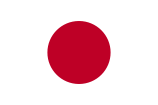 - Shimonoseki, Japan (3 October 1979)
- Shimonoseki, Japan (3 October 1979) - Long Beach, California, USA (12 April 1985)[2]
- Long Beach, California, USA (12 April 1985)[2] - Acapulco, Mexico (21 August 1985)
- Acapulco, Mexico (21 August 1985) - Wilhelmshaven, Germany (1992)
- Wilhelmshaven, Germany (1992) - Odessa, Ukraine (29 April 1993)
- Odessa, Ukraine (29 April 1993) - Daegu, South Korea (4 December 1993)
- Daegu, South Korea (4 December 1993) - Nes Ziyyona, Israel (2 December 1997)
- Nes Ziyyona, Israel (2 December 1997) - Velsen, the Netherlands (9 December 1998)
- Velsen, the Netherlands (9 December 1998) - Southampton, UK (27 December 1998)
- Southampton, UK (27 December 1998) - Galway, Ireland (1999)
- Galway, Ireland (1999)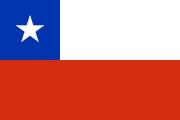 - Puerto Montt, Chile (17 August 1999)
- Puerto Montt, Chile (17 August 1999) - Paderborn, Germany (2003)
- Paderborn, Germany (2003)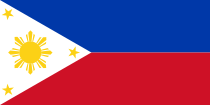 - Iloilo City, Philippines, (2003)
- Iloilo City, Philippines, (2003) - Montevideo, Uruguay, (15 April 2004)
- Montevideo, Uruguay, (15 April 2004)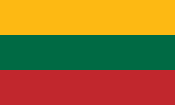 - Klaipėda, Lithuania (30 May 2004)
- Klaipėda, Lithuania (30 May 2004)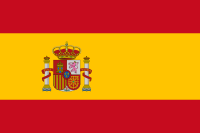 - Bilbao, Spain (21 August 2004)
- Bilbao, Spain (21 August 2004) - Nantes, France (June 4 2005)
- Nantes, France (June 4 2005) - Miami, Florida, USA (30 August 2005)
- Miami, Florida, USA (30 August 2005) - St Petersburg, Russia (8 October 2006)
- St Petersburg, Russia (8 October 2006)
Friendly co-operative cities
Qingdao is a friendly co-operative city of the following cities around the world.
 - Gothenburg, Sweden (1994)
- Gothenburg, Sweden (1994) - Mannheim, Germany (1985)
- Mannheim, Germany (1985) - Incheon, South Korea (1995)
- Incheon, South Korea (1995) - San Francisco, USA (1997)
- San Francisco, USA (1997) - Chisinau, Moldova (1997)
- Chisinau, Moldova (1997)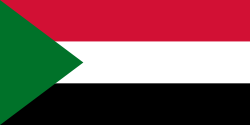 - Port Sudan, Sudan (1998)
- Port Sudan, Sudan (1998) - Orange County, Florida, USA (1998)
- Orange County, Florida, USA (1998) - Tangier, Morocco (1999)
- Tangier, Morocco (1999) - Rijeka, Croatia (1999)
- Rijeka, Croatia (1999) - Pyeongtaek, South Korea (1999)
- Pyeongtaek, South Korea (1999) - Naruto, Japan (1999)
- Naruto, Japan (1999) - West Gotland, Sweden (1999)
- West Gotland, Sweden (1999)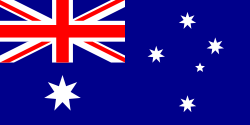 - Adelaide, Australia, (2000)
- Adelaide, Australia, (2000) - Da Nang, Vietnam ( 2000)
- Da Nang, Vietnam ( 2000) - Nicosia, Cyprus (2000)
- Nicosia, Cyprus (2000) - Edmonton, Canada (2000)
- Edmonton, Canada (2000) - Oakland, USA (2000)
- Oakland, USA (2000) - Los Angeles, USA (2000)
- Los Angeles, USA (2000)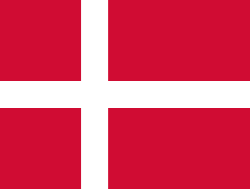 - Skagen, Denmark (2000)
- Skagen, Denmark (2000) - Brest, France (2002)
- Brest, France (2002) - Kobe, Japan (2003)
- Kobe, Japan (2003) - Fukuoka, Japan (2003)
- Fukuoka, Japan (2003) - Busan, South Korea (2003)
- Busan, South Korea (2003) - Gunsan, South Korea (2003)
- Gunsan, South Korea (2003) - Cairns, Australia, (2003)
- Cairns, Australia, (2003) - Iloilo, Philippines, (2003)
- Iloilo, Philippines, (2003) - Veneto, Italy, (2004)
- Veneto, Italy, (2004) - Braunau, Austria, (2004)
- Braunau, Austria, (2004) - St Louis, USA (2004)
- St Louis, USA (2004) - Vento, Italy, (2005)
- Vento, Italy, (2005) - Kitakyushu, Japan (2005)
- Kitakyushu, Japan (2005) - Houston, USA (2006)
- Houston, USA (2006) - Perm, Russia (2006)
- Perm, Russia (2006)
References
- ↑ Jing, Fu (2006-01-03). "Beijing drops out of top 10 'best city' list", China Daily.
- ↑ SMS Cormoran was one of the German vessels to ship out from Tsingtao
- ↑ see Battle of Coronel and Battle of the Falkland Islands for fleet engagements
- ↑ Until August 2008, travellers not from Qingdao are often confused in that railway tickets to Qingdao are listed as destined for "Sifang". These trains, in reality, are headed to Qingdao's Sifang District. The destination's name will revert to "Qingdao" once renovations to the larger Qingdao Railway Station is complete.
- ↑ Tsingtau-Biographien [1]
External links
- Qingdao Government website
- Qingdao travel guide from Wikitravel
- Window of Qingdao (Chinese)
|
||||||||||||||||||
|
||||||||||
|
||||||||||||||||||||||||
|
||||||||||||||||||||||



